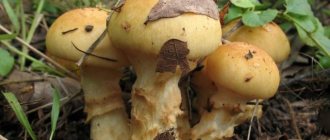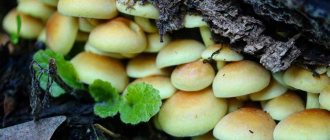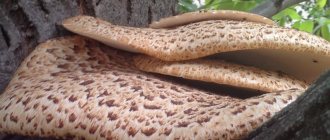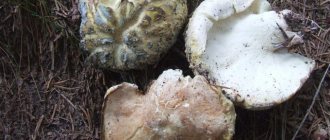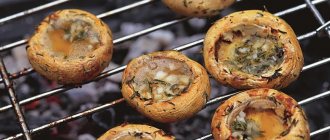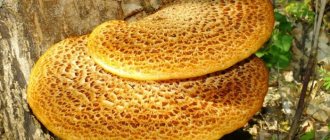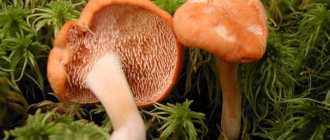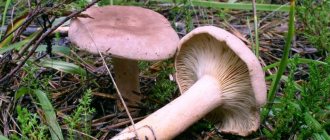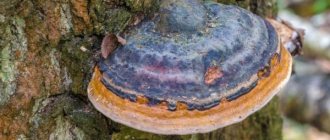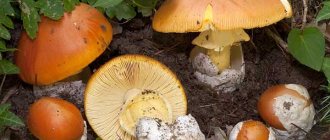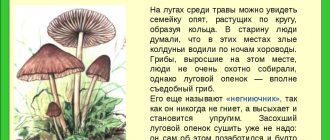Description of the sulfur-yellow tinder fungus
The species belongs to the genus Letiporus of the Fomitopsis family. It is popularly called Witch's Brimstone, Kulyna, Chicken Mushroom and Chicken Mushroom. The association with poultry arose from the chicken-like flavor of the pulp of cooked tinder fungi.
What they look like
Mushrooms are shapeless growths on wood. At first glance, it may seem that a dough-like mass is protruding from a crack in the tree bark.
The color of the tinder fungus depends on the stage of development of the fungal organism. Young fruits are painted a pale shade of yellow. Over time they gradually become more orange. Overripe mushrooms have a bright orange-pink color. The edges of the cap always remain yellow.
Structure and features
This type of tinder fungus has a sessile fruiting body. The mushroom is characterized by the following features:
- Young fruits do not have a specific shape. They are a bubbly mass the size of a large drop. As it develops, the fungus takes on the cantilever shape characteristic of tinder fungi. The fruit consists of several pseudocaps, fused together and covered with short fluff.
- In mature mushrooms, the pseudocaps are kept almost separately, while in young ones they form a shapeless cluster.
- At an early stage of development, the fruits are soft. Over time they become harder and harder.
- The diameter of each pseudocap in a mature tinder fungus can reach up to 30-40 cm in diameter. Typically, the weight of the fetus varies from 5 to 10 kg.
- The tubular hymenophore is located on the inner side of the pseudocap. In this variety it is finely porous, colored with a sulfur tint of yellow. In young mushrooms, drops of yellowish liquid may be released from the pores.
Chemical composition and calorie content
The medicinal properties of the sulfur-yellow tinder fungus are determined by its chemical composition. The pulp of the mushroom contains:
- enzymes;
- vitamins;
- proteins and amino acids;
- dextrins;
- minerals;
- glycogens;
- tannins and saponins.
The young fruiting bodies of the sulfur-yellow tree fungus are edible and have a pleasant taste and smell. The energy value of the product is about 24 calories per 100 g.
We recommend reading: Saffron: beneficial properties, how to use and take
Where does laetiporus sulphureus grow, in which forests and how to collect
In Russia, tinder fungi are distributed almost everywhere. They can be found in the central part of the state, in the Far East, and in Siberia. True, this type of mushroom is considered quite rare. But myceliums usually settle in large groups. Therefore, if you come across one chicken mushroom, you can reap quite a decent harvest.
You need to go for tinder fungi in deciduous forests. They grow on dead or severely weakened willows, alders, ash trees, and poplars. Less commonly, witch's sulfur can be found in city parks and squares on linden and chestnut trees. The mushroom can even grow in the garden on the bark of a nut or pear.
Myceliums bear fruit from May to October. The peak season is in the summer months. The first wave, May-June, is considered the most productive.
Spreading
The tinder fungus is sulfur-yellow.
The sulfur-yellow tinder fungus is a typical tree parasite. It grows on the trunks and stumps of a wide variety of temperate trees. It can be found everywhere throughout the Northern, and to a lesser extent in the Southern Hemisphere, on all continents. It is most widespread as a conditionally edible plant in the USA and Germany.
Chicken mushroom can be found in forests and gardens, less often - on separate trees: oak, willow, linden, maple, elm, poplar, chestnut, walnut. It also affects fruit trees. Of the conifers, it most often grows on larch and pine. It can be found much less frequently on spruce.
In Western Siberia, approximately a quarter of all trees are affected by tinder fungus. The tinder fungus provokes drying out and damage to the trunk over a length of almost 4 m. Over time, the affected area grows, covering the entire tree.
What mushrooms can be confused with and how to distinguish them
A novice mushroom picker may mistake the tinder fungus for some other similar species. But it is not difficult to distinguish mushrooms, knowing their characteristic species characteristics.
Northern hedgehog
Mushrooms have a similar structure of fruiting bodies. The hedgehog also consists of several pseudocaps fused at the base. The fruits of both varieties reach approximately the same size. In addition, hedgehog mushrooms, like chicken mushrooms, grow on deciduous trees and both species are found at the same time of year.
You can distinguish a hedgehog by the following features:
- spiny spore layer on the back of the pseudocap;
- grayish-yellow color of fruiting bodies, which over time can fade to a whitish tint or turn green from mold;
- The pulp is very hard and smells unpleasant.
This variety of hedgehog mushrooms is considered inedible due to the high degree of hardness of the pulp and its repulsive odor. Therefore, their fruits are not used in cooking. But insects, on the contrary, consider the northern hedgehog to be very tasty. In places where this species grows, you can often find completely eaten mushroom spots.
Meripilus gigantea
Among the interspecific similarities, one can highlight the absence of a mushroom stem, a pile of pseudocaps fused together, the time of fruiting and the ability to grow on deciduous trees. True, the meripilus are located closer to the base of the tree, without rising to a great height.
Meripulus differs from tinder fungus in the following features:
- fruit weight ranges from 25 to 30 kg;
- pseudocaps grow in a semicircle;
- the color of the fruit varies from reddish to brown-brown;
- the surface of the pseudocaps is velvety to the touch, dotted with small scales and dotted with grooves, the color of which differs from the main color;
- the sweetish white flesh turns red at the break.
On a note!
Giant Meripulus are edible. But only young fruits are used for food purposes.
Notes
- [www.mycobank.org/MycoTaxo.aspx?Link=T&Rec=372852 Laetiporus conifericola at www.mycobank.org]
- ↑ 12
(English) [academic.evergreen.edu/projects/mushrooms/phm/s66.htm POISONOUS AND HALLUCINOGENIC MUSHROOMS by Michael W. Beug, The Evergreen State College, Olympia WA] - (English) [www.discoveringalabama.org/discovery/details.php?item=85 www.discoveringalabama.org]
- Laetiporus sulphureus causing visual hallucinations and ataxia in a child RE Appleton, JE Jan, and PD Kroeger CMAJ 1988 139: 48-49.
- Kapich A. N., Gvozdkova T. S., Kvacheva Z. B., Nikolaeva S. N., Shishkina L. N., Galkin S., Khatakka A., Konoplya E. F., Vereshchako G. G., Khodosovskaya A. M., Rutkovskaya Zh. A. Antioxidant, radioprotective and antiviral properties of extracts of mycelium of the fungus Laetiporus sulphureus // Advances in medical mycology. 2004. 3: 146–148.
Edibility, benefits, harm and restrictions on use
This species belongs to the conditionally edible mushroom category. Only young, soft and juicy fruits are used in cooking. You can prepare a wide variety of mushroom dishes from them. But immediately before cooking, the mushrooms are pre-boiled for 45 minutes.
Each mushroom product contains a lot of useful substances. Kulyn is a valuable source of vitamins and minerals. And in terms of the number of free amino acids they have no equal. But mushroom dishes should be consumed with caution.
Witch's sulfur can only be eaten in strictly limited quantities. It is not for nothing that some mycological reference books present this species as slightly poisonous. Mushrooms can cause stomach upset, accompanied by dizziness and vomiting. Often, after eating polypores, allergic reactions are observed - skin rashes, swelling of the lips. The literature describes cases of visual hallucinations due to the consumption of fruits of this species.
Improperly prepared mushrooms can cause serious harm to the body. The same thing can happen due to violation of collection rules.
Important!
Only young fruits, the smell of which has not yet developed unpleasant notes, can be used for food. Kulyna can only be collected from deciduous trees. Polypores growing on conifers are toxic. Some mycologists even consider such mushrooms as an independent species - letiporus coniferous-woody.
Polypores should not be given to children as food. Also, their fruits are not recommended for use by women during pregnancy and breastfeeding.
Contraindications
The sulfur-yellow tinder fungus is not only beneficial for the human body, but can also cause severe harm to health . Therefore, you need to know what the contraindications to its use are.
It is forbidden to consume sulfur-yellow polypores during pregnancy and lactation . Fungal substances can provoke allergies in a child and also reduce the quality of milk. Also, children under 14 years of age should not eat mushrooms, as they may develop problems with the digestive system.
So, now you know what sulfur-yellow tinder fungus looks like and what beneficial properties it has. Despite its beautiful appearance, this fungal group can cause poisoning. To exclude this, try to collect only young mushrooms that have a pleasant aroma. You cannot take tinder fungi growing near roads or industrial plants into the basket. This is due to the fact that they absorb all negative substances from the soil and air. If you consume them, you can cause harm to your body.
Medicinal properties of sulfur-yellow tinder fungus
There is a widespread belief that these polypores have medicinal properties. Russian pharmacology does not use fruits for the manufacture of medications due to the lack of necessary research. Traditional medicine uses kulyna remedies to treat the following diseases:
- diseases of the upper and lower respiratory tract;
- kidney disease;
- liver dysfunction;
- obesity;
- disorders of the cardiovascular system.
You may be interested in: How do edible talkers differ from false mushrooms? How many days after rain do mushrooms grow? Bitter mushroom: photo and detailed description
Traditional healers use powders and tinctures from tinder fungi to enhance natural immunity. Some of them undertake to treat alcoholism, diabetes and even epilepsy with the help of these mushrooms.
Dried kulyna fruits are ground into powder using a blender or meat grinder. The resulting mass is stored in the refrigerator. The powder is taken with plain water, ½ tsp. The duration of therapy depends on the nature of the disease.
To prepare the tincture, 40 g of mushrooms are poured with ½ liter of twenty percent alcohol. It is permissible to use regular vodka by diluting it with an equal amount of boiled water. The medicine is infused for 3 days. After the specified time, the tincture is stored in the refrigerator. Usually it is taken 3 times a day, 1 tbsp. l. before eating. On average, the course of treatment with tincture lasts up to 10 days.
Interesting!
The practice of using kulyna fruits for medicinal purposes is widespread in Japan. There, mushrooms are actively used to treat pneumonia, bronchitis, and some liver and kidney diseases.
Polypores parasitize trees, causing them irreparable harm. Young fruits can be eaten after mandatory heat treatment. The medicinal properties of mushrooms have not been proven by traditional medicine. If a person nevertheless decides that tinder fungus therapy is necessary, he should consult a homeopathic doctor before taking the medicine.
Features of cooking chicken
Chickens are universal in gastronomic terms and are subject to any heat treatment. Usually they are boiled, fried or made homemade for the winter. Young mushrooms are considered the most appetizing.
How long to cook
Don't overcook them. 5-10 minutes of cooking is enough if we are talking about processing before further cooking.
On a note!
If you plan to prepare chickens for the winter, boil them for about 25 minutes.
Fried mushrooms in a frying pan
The caps can be fried fresh or pre-boiled. Fried cockerels in batter are extremely tasty. The method for preparing them is simple:
- The peeled caps are dipped in a batter of flour, salt and eggs.
- Breaded in breadcrumbs.
- Vegetable oil is poured into a hot frying pan so that the mushrooms are deep-fried.
- The heat is reduced and the cockerels are placed in the frying pan. When they are browned, they are turned over and browned on the other side.
- Cooking time – 5-7 minutes. For crispy frying, you can place the mushrooms in the oven for half an hour at 180°C.
The dish is equally tasty both hot and cold. An excellent sauce for it would be sour cream with garlic and herbs.
Preparations for the winter
A variety of preparations are made from cockerels:
- marinate;
- salted;
- dried;
- fermented.
It is recommended to marinate these mushrooms so that neither salt, nor seasonings, nor acetic acid interrupt the delicate flavor, but, on the contrary, emphasize it. To do this, add cumin and rosemary.
Pickled cockerels deserve special attention. The mushrooms are first blanched, washed with cold water, mixed with spices (garlic, horseradish, bay leaf, mustard seeds), and then fermented under pressure for 5-10 days. Then put it in a container and store it in the refrigerator.
Lamellar orange species
It is worth paying attention to those forest inhabitants who have lamellar hymenophores. Thus, there are many species with a red cap, both edible, conditionally edible, and poisonous.
Saffron milk caps
Camelinas are an excellent example of an edible mushroom that is completely orange in color, considered a real delicacy among connoisseurs who use their small funnel-shaped fruits for pickling. Distinctive characteristics include a glossy, smooth cap with inwardly curved edges, sometimes covered with thick mucus, and a short, barrel-shaped stem.
Chanterelles
Chanterelles, often growing in entire families, are a real dream for many mushroom pickers. These fruits make excellent pickles, marinades and casseroles. Chanterelles are good just fried, and even with potatoes, especially considering that they are never wormy. The only drawback of the variety is that it has a double, which is considered dangerous for consumption.
False chanterelle on a thin leg
A false variety of edible mushroom is also common, differing from it in having perfectly smooth edges and a pungent rotten odor. Surprisingly, culinary specialists in some countries are not embarrassed by this feature, as a result of which the conditionally edible double has become widely used after long-term heat treatment.
Plush web spider
But tasting cobwebs can result in the most severe complications, including death, so it is better never to add its convex, rounded fruits with a small characteristic tubercle in the central part and a thin stem tapering downward to your basket.
Milky non-caustic
This variety belongs to the Russula family, having a funnel-shaped cap of a delicate apricot shade. To the touch, the surface of the mushroom, which rarely grows to a diameter of 6 cm, is absolutely dry and pleasantly velvety, while its brighter orange flesh and milky juice are practically odorless and tasteless when raw. It is usually used for pickling, belonging to category IV in terms of its taste.
Orange row
This species has an important distinctive characteristic, which is the ability to change the color of the cap and hymenophore as it matures, from lemon-greenish to red or even brown.
The stem of such mushrooms is also not the same, sometimes having an elongated cylindrical shape, sometimes resembling a dense barrel with a clear thickening in its lower part. The fleshy pulp of the row has a dense structure and white color, without changing it even upon contact with the external environment.
Almost all of the listed mushrooms are used in cooking only after soaking and boiling, which helps neutralize toxins, as well as the unpleasant bitterness and sourness inherent in many conditionally edible varieties. If a mushroom picker has at least some doubt about the edible qualities of the crop, then it is better not to risk throwing it away.
Growing
All tinder species reproduce by spores - they are located on the basidia. Groups of spores, maturing in tubes tightly fused together, spill out. They are carried away by the wind to new habitats. Once on fertile soil - old or damaged wood, they begin to reproduce. A mycelium is formed, which, branching along the tree bark, destroys it.
Growing on substrate
Polypores are easy to cultivate. They are grown in substrate. To prepare it you need:
- sawdust;
- shavings;
- bark of small branches.
Stumps and wooden beams can be used as a substrate. After making holes with a drill, the mycelium is placed in them.
The order of mycelium laying:
- The mixture is poured with boiling water.
- When the temperature of the substrate drops to room temperature, it is squeezed out and mixed with mycelium.
- Place in plastic bags.
- Having made slits in the bags, they are placed in a room where the humidity is 80%. Lighting – natural, temperature – 20°C.
- The harvest will be ready after 30-40 days.
Growing on stumps
Instead of a substrate, you can use stumps and wooden beams. Disembarkation order:
- The wood is kept in water.
- The required number of cuts are made on the soaked wood - they are sawed out or drilled.
- The mycelium is placed into the cuts made.
- Wooden beams are placed in a shady place and covered with foliage.
The “crops” are watered from time to time, this is especially important during drought. The first mushrooms will appear in 4 months.
Polypores are a real gift of nature. You should not perceive them negatively - there is nothing superfluous in nature, and tinder fungi are only part of the cycle of substances. Polypores are invaluable for pharmacology and a real treasure for medicine. And edible mushrooms of this family are also excellent meat substitutes.
Links
- (English) [www.mycobank.org/MycoTaxo.aspx?Link=T&Rec=299348 Taxonomy and scientific descriptions on the website www.mycobank.org]
- [www.naturephoto.ru/Images/Sulfur-web.jpg Good photo of a mushroom]
- [mycoweb.narod.ru/fungi/Photocollection2.html?Laetiporus_sulphureus Collection of photographs of the sulfur-yellow tinder fungus from the site mycoweb.narod.ru]
- [mycoweb.narod.ru/fungi/Recipes/Laetiporus_sulphureus_Recipes.html Dishes made from yellow sulphureus tinder]
| : Incorrect or missing image | This article lacks links to sources of information. Information must be verifiable, otherwise it may be questioned and deleted. You may edit this article to include links to authoritative sources. This mark is set May 15, 2011 . |
K:Wikipedia:Articles without sources (type: not specified)
Porous mushroom Favolashia calocera
This southern beauty grows on the wood of deciduous trees, the tubular hymenophore of which resembles a loose sponge. The color of the variety varies from pale yellow to rich orange, despite the fact that the mushrooms are miniature in size, rarely exceeding 3 cm in diameter.
These representatives of the Micenov family reproduce by white ovoid spores, hiding them in their sponge. At a young age, the pulp of these mushrooms has an elastic, slightly gelatinous consistency, but as it ages, it increases its elasticity, beginning to resemble rubber.
Interesting!
It is worth noting that it is almost impossible to find favolashia in Eurasia, with the exception of China, which has forests with these bright sunny fungi.
Places where orange mushrooms grow
The habitat of forest inhabitants of the orange group directly depends on their species, and if we talk about the most common boletus with its strong high leg and bright red cap, then it is found in almost all mixed forests where crops such as oak, birch, hornbeam, and beech grow , aspen and poplar, preferring to settle in close proximity to them.
Another common representative of the orange mushroom family is the row. Its myceliums develop mainly in deciduous tracts and birch forests of the Urals, the middle zone of the Eurasian continent and the Far Eastern regions, forming the so-called witch’s rings.
It is believed that mushrooms do not grow in the south, but the orange porous mushroom is a clear refutation of this stereotype, because its loose, bright fruits can be found in Australia, New Zealand, Italy and even Africa, if you go to the exotic island of Madagascar.
If we talk about the most northern varieties, then it is worth paying attention to the petsitsa or orange aleuria with its fiery colors, which actively grows in mixed taiga forests, forming entire colonies directly on stones covered with dead wood.
There are also species that prefer to settle directly on stumps or on dying tree trunks, feeding on their decomposition products, and among them is the tinder fungus, a conditionally edible mushroom that looks like a lush rosy omelette.
